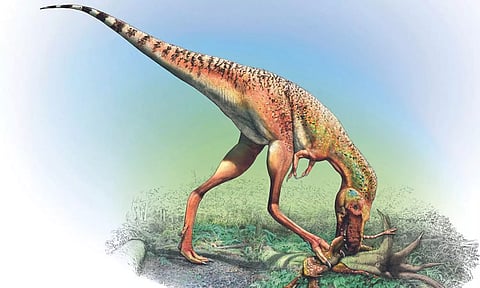

• MICHAEL GRESHKO
Some 75.3 million years ago, a dinosaur swallowed the Cretaceous equivalent of a turkey drumstick. It would turn out to be the predator’s final feast. Within days of eating that haunch, the dinosaur — a juvenile Gorgosaurus that stood 5 and a half feet tall at the hip — ended up dead in a river. By a stroke of geological luck, sediments rapidly covered much of the carcass and protected the dinosaur, and its dinner, from decay.
The resulting fossil, unveiled Friday in the journal Science Advances, is the first tyrannosaur skeleton ever found with stomach contents still preserved inside, yielding an exquisite snapshot of its feeding behavior. The fossil also preserved much of the skull, pelvis and left side of the Gorgosaurus’s body. Gorgosauruses were ancestral relatives of Tyrannosaurus rex, but this fossil doesn’t contain a speck of the large herbivores on which adult tyrannosaurs feasted. Instead, this Gorgosaurus ripped the hind limbs off two small feathered dinosaurs. Researchers say the fossil provides the first direct evidence that tyrannosaurs changed what they ate as they aged, which paleontologists had predicted from existing fossil evidence.
“With this specimen, we have physical proof that young tyrannosaurs not only fed on different animals than their adult counterparts, but they also attacked or dissected them differently,” said François Therrien, the curator of dinosaur paleoecology at the Royal Tyrrell Museum in Drumheller, Alberta, and an author of the study. Previously discovered coprolites — fossilized poop — and bones damaged by teeth or stomach acid show that adult tyrannosaurs feasted on large plant-eating dinosaurs such as Triceratops with bone-crunching gusto. But before they could take down mega-herbivores, tyrannosaurs had to grow larger, and their skulls and teeth had to grow wide and robust enough to generate one of nature’s most powerful bites.
Juvenile tyrannosaurs, however, had skinny skulls, narrow jaws, blade-like teeth and long legs. Paleontologists had interpreted these traits as signs that young tyrannosaurs must have been nimble, an idea supported by the new fossil. “I jokingly refer to them as the ballerinas of doom: fast-running, fast-turning and able to go after small, fast-running prey,” said Tom Holtz, a paleontologist at the University of Maryland who was not involved with the study.
The Gorgosaurus specimen was discovered in August 2008 by Darren Tanke, a technician at the Royal Tyrrell Museum. Weathering had exposed its ribs in a hillside in Dinosaur Provincial Park in Alberta. The stomach contents consist of hind limbs and a partial tail from beaked dinosaurs known as Citipes, which resembled shrunken cassowaries.
Each of the two Citipes was less than a year old when eaten, and, based on the bones’ degree of acid wear, the Gorgosaurus ate them during the final week of its life, one a few days before the other. Despite stewing in the Gorgosaurus’s gastric juices, the Citipes bones are so well preserved that they are the most complete fossils of the animal ever found.